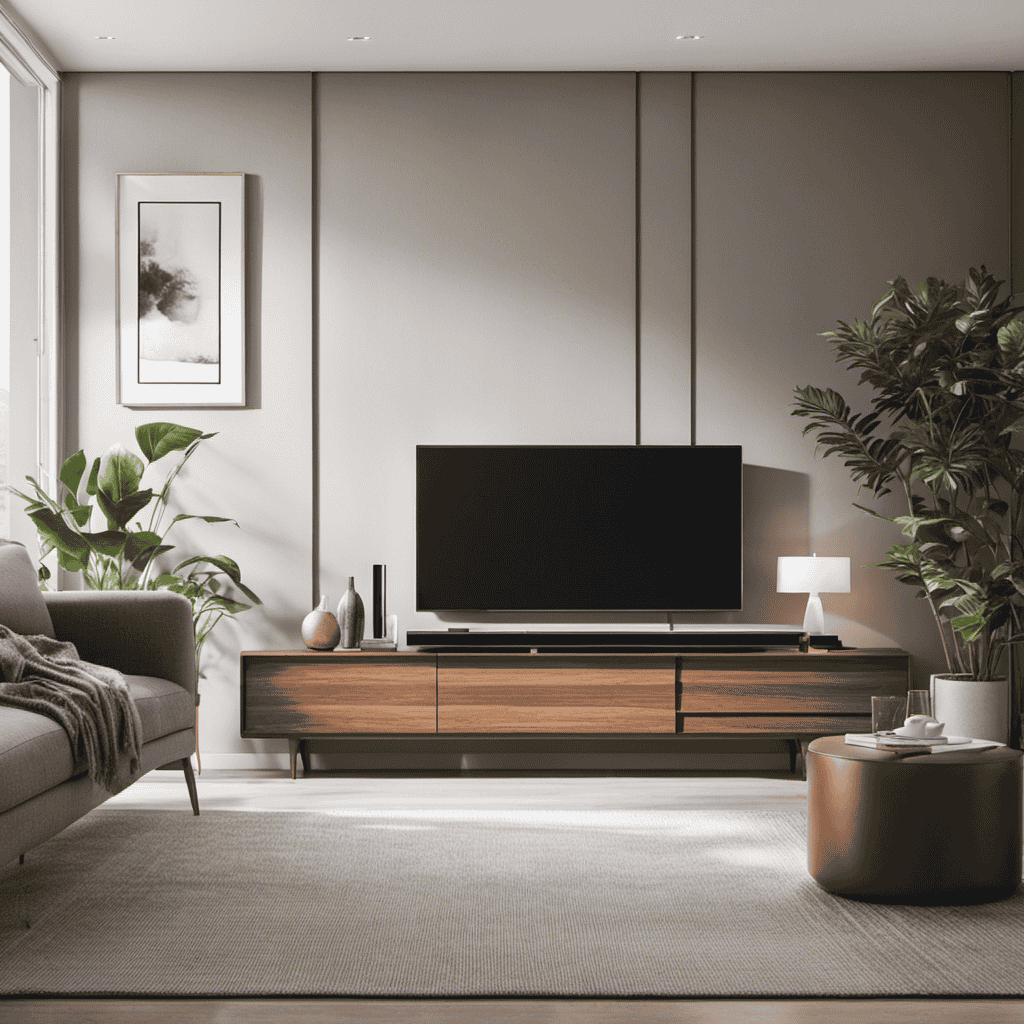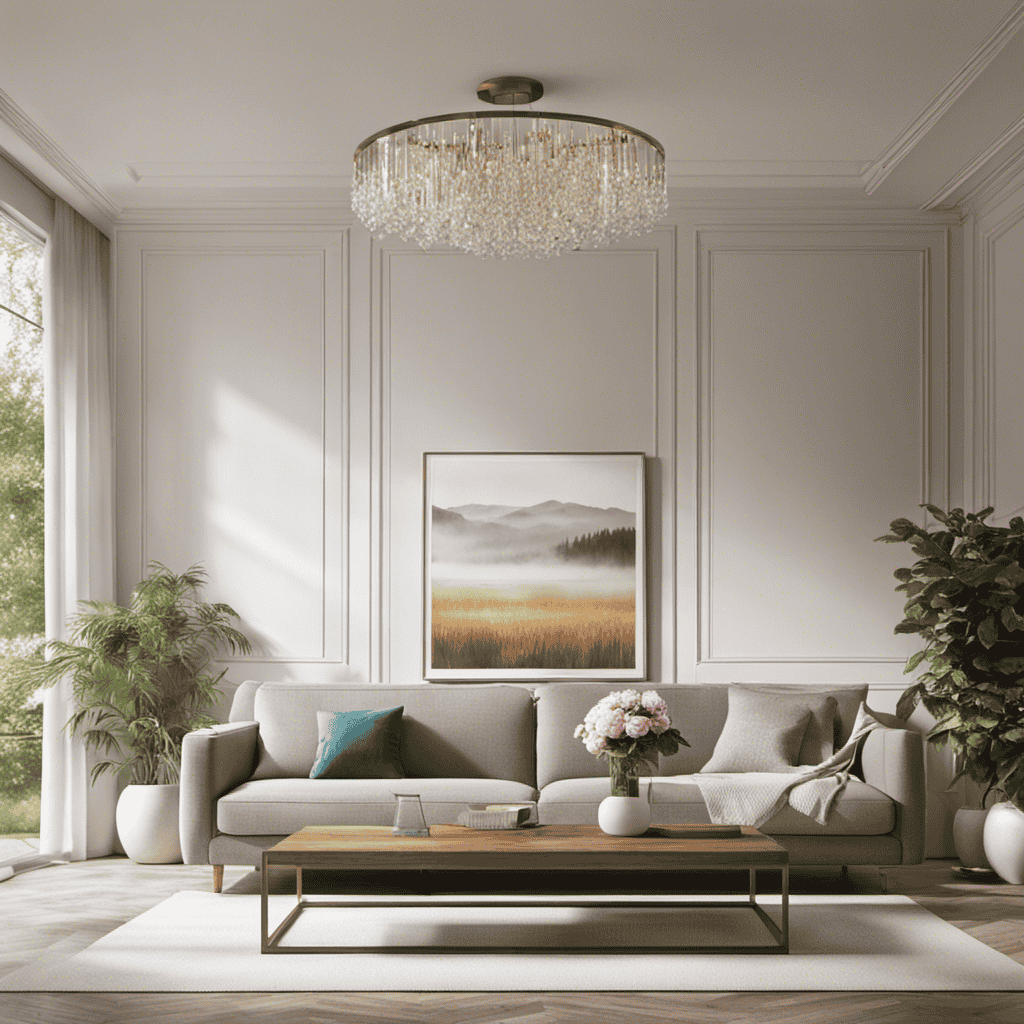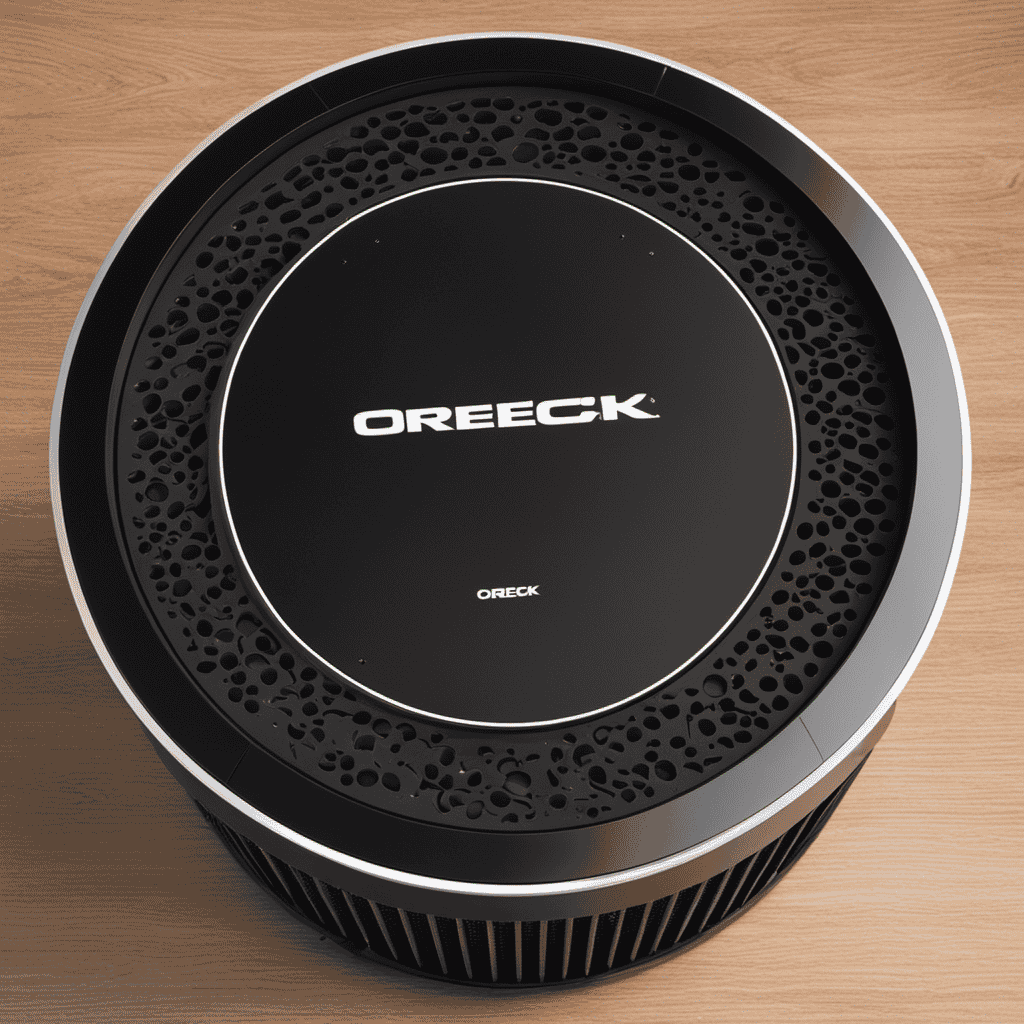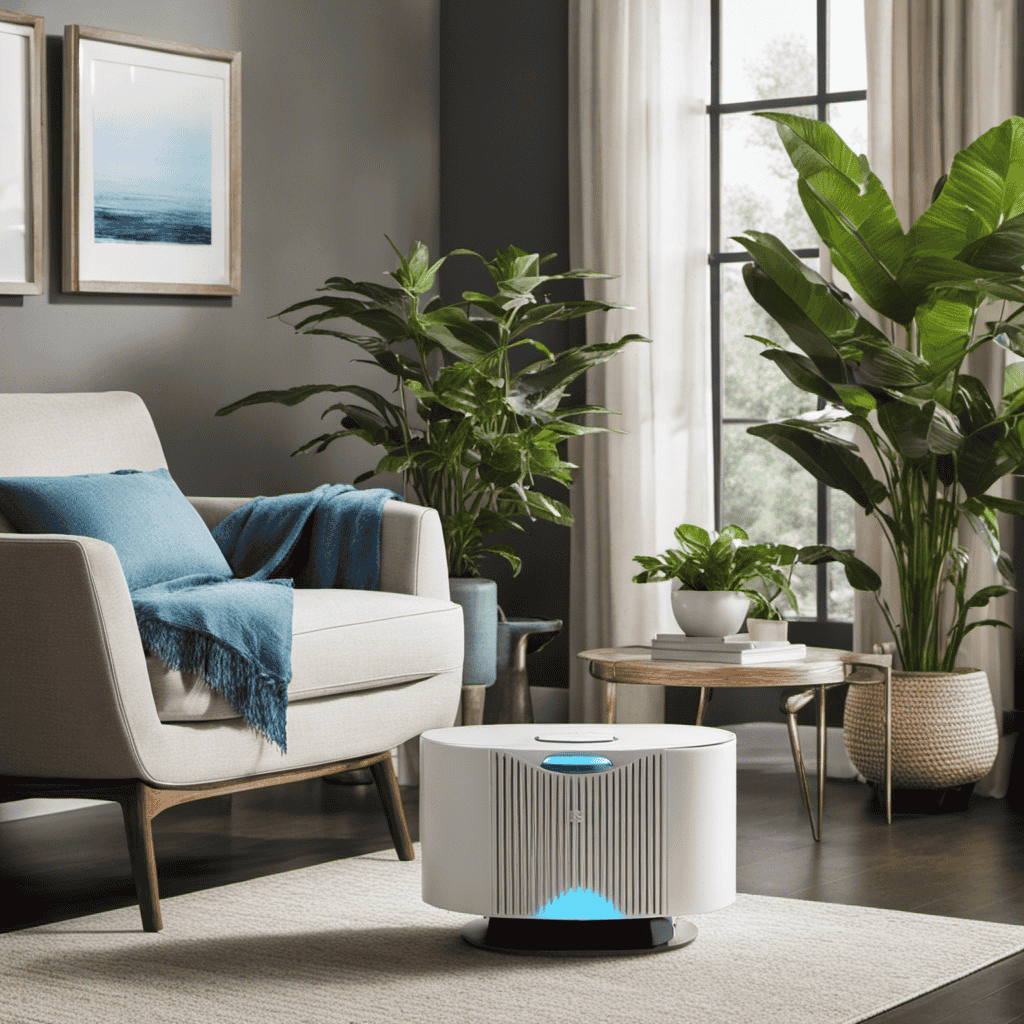Did you know that indoor air can be up to 5 times more polluted than outdoor air? That’s why selecting the correct air purifier is crucial for keeping a healthy living space.
In this article, I will guide you through the key factors to consider when buying an air purifier. From size and coverage area to filtration technology and additional features, I’ll provide you with the information you need to make an informed decision.
So, let’s dive in and find the perfect air purifier for you.
Key Takeaways
- Consider the size of the room and choose an air purifier that matches the size and coverage needs.
- Look for air purifiers that use a combination of filtration technologies such as HEPA filters, activated carbon filters, and UV germicidal lamps for comprehensive purification.
- Opt for air purifiers with air quality sensors and indicator lighting systems to provide real-time monitoring of air quality and ensure effective purification.
- Take into account the noise level of the air purifier and look for models with adjustable fan speeds or sleep mode for whisper-quiet operation, based on customer reviews and ratings.
Size and Coverage Area
When purchasing an air purifier, it’s important to consider the size and coverage area. Air purifier features and room size compatibility play a crucial role in determining the effectiveness of the device. Before making a purchase, it’s essential to measure the size of the room or area where you plan to use the air purifier.
Different models have varying capabilities, and choosing one that matches your room size ensures optimal performance. Additionally, consider the coverage area that the air purifier can handle. Some models are designed for small rooms, while others can effectively clean the air in larger spaces. Understanding these factors will help you select an air purifier that best suits your needs.
Now, let’s explore the next important aspect of air purifiers: filtration technology.
Filtration Technology
One important factor to consider is the type of filtration technology used in an air purifier. There are different filtration options available in air purifier technology, each with its own advantages and limitations. The most common types of filtration technologies used in air purifiers include HEPA filters, activated carbon filters, and UV germicidal lamps.
HEPA filters are highly effective at removing airborne particles like dust, pollen, and pet dander. Activated carbon filters are great for eliminating odors and absorbing harmful gases. UV germicidal lamps are useful in killing bacteria and viruses. It’s important to choose an air purifier that uses a combination of these technologies to ensure comprehensive air purification.
Now let’s move on to discuss the importance of air quality sensors and indicators in an air purifier.
Air Quality Sensors and Indicators
When it comes to air quality, sensors play a crucial role in ensuring that we breathe clean and safe air.
These sensors are designed to detect various pollutants and provide real-time monitoring of the air quality in our surroundings.
One innovative feature that is often incorporated in air purifiers is an indicator lighting system that visually displays the current air quality level, allowing us to take necessary actions to improve it.
Importance of Sensors
The importance of sensors in air purifiers cannot be overstated. These sensors play a crucial role in ensuring the effectiveness of air purifiers and maximizing the benefits of air purification.
By constantly monitoring the air quality in a room, sensors can detect pollutants such as dust, allergens, and volatile organic compounds (VOCs). They provide real-time data and feedback, allowing the air purifier to adjust its settings accordingly, ensuring that the air is consistently clean and healthy.
Sensors also help to indicate when it’s time to replace filters, ensuring optimal performance. With the help of sensors, air purifiers can efficiently remove harmful particles from the air, improving indoor air quality and reducing the risk of respiratory issues.
Real-Time Air Monitoring
By constantly monitoring the air quality in a room, sensors can provide real-time data and feedback, allowing the air purifier to adjust its settings accordingly.
Air quality monitoring is a crucial feature to consider when buying an air purifier. These sensors measure various pollutants and contaminants present in the air, such as dust, pollen, pet dander, and volatile organic compounds (VOCs).
With real-time data, the air purifier can accurately assess the air quality and make necessary adjustments to its filtration system. This ensures that the purifier is operating at optimal performance, removing harmful particles efficiently.
Real-time monitoring also allows users to track the progress and effectiveness of their air purification system, providing valuable insights into the indoor air quality.
Overall, air quality monitoring and real-time data are essential features that enhance the efficiency and effectiveness of an air purifier.
Indicator Lighting System
An indicator lighting system on an air purifier uses different colors to provide real-time feedback on the current air quality. This feature is present in many air purifier brands and is a valuable tool for monitoring the effectiveness of the device.
The indicator lights typically range from green, indicating good air quality, to yellow or orange, indicating moderate air pollution, and finally to red, indicating poor air quality. This system allows users to easily determine the current state of their indoor air and take appropriate action if necessary.
When comparing air purifiers, it is important to consider the cost of replacement indicator lights, as they may need to be replaced periodically.
Now, let’s transition into the next section about noise level, which is another important factor to consider when purchasing an air purifier.
Noise Level
When choosing an air purifier, you’ll want to consider the noise level. A silent operation is essential, especially if you plan to use it in your bedroom or office. The decibel level is an important factor to assess the noise level of an air purifier.
Here are some key points to keep in mind:
- Look for air purifiers with a decibel level of 30 or lower for a whisper-quiet operation.
- Consider air purifiers with adjustable fan speeds, allowing you to customize the noise level to your preference.
- Some air purifiers come with a sleep mode, which reduces the fan speed and noise level during nighttime use.
- Check for customer reviews or ratings that mention the noise level to get a better understanding of how quiet or loud the air purifier is in real-world usage.
Energy Efficiency
Considering energy efficiency is crucial when selecting an air purifier. It can help you save on electricity costs in the long run. Energy consumption is an important factor to consider because it directly affects your monthly bills.
When researching air purifiers, look for models that have an Energy Star certification. These devices are designed to use less energy without compromising their effectiveness. By choosing an energy-efficient air purifier, you can enjoy cleaner air while reducing your carbon footprint and saving money.
It’s important to note that energy-efficient models may have a higher upfront cost, but the long-term cost savings make them a worthwhile investment. So, before making a purchase, take the time to compare energy consumption and potential cost savings to make an informed decision.
Maintenance and Filter Replacement
Maintaining and replacing filters regularly is essential for keeping your air purifier functioning effectively. Filters are responsible for trapping and removing allergens, dust particles, and other pollutants from the air. Neglecting filter maintenance can lead to decreased air purification efficiency and potentially harmful air quality.
Here are a few key points to consider regarding maintenance and filter replacement:
-
Maintenance frequency: The frequency at which you should clean or replace your filters depends on factors like the manufacturer’s recommendations, the level of air pollution in your area, and the specific model of your air purifier.
-
Filter lifespan: Filter lifespan varies depending on the type of filter and usage. Some filters may last up to six months, while others may need to be replaced more frequently.
-
Regular cleaning: Cleaning reusable filters can prolong their lifespan and maintain optimal air purification performance.
-
Filter replacement: When it’s time to replace your filters, make sure to purchase genuine replacements from the manufacturer for compatibility and efficiency.
Proper maintenance and timely filter replacement will ensure your air purifier continues to provide clean, fresh air.
Now, let’s explore additional features and convenience options to consider when buying an air purifier.
Additional Features and Convenience Options
When it comes to air purifiers, there are several additional features and convenience options to consider.
One important feature is smart home integration, which allows you to control your air purifier using voice commands or through a mobile app.
Another useful feature is the filter replacement indicator, which notifies you when it’s time to change the filters, ensuring optimal performance.
Additionally, noise level control is an important consideration, as some air purifiers can be quite loud and disruptive.
Smart Home Integration
Smart home integration allows me to control my air purifier remotely using voice commands or a smartphone app. This feature is made possible through IoT connectivity and voice control technology. With just a simple voice command or a tap on my phone, I can adjust the settings of my air purifier from anywhere in my home. This convenience brings a whole new level of ease to maintaining clean and fresh air in my living space.
The benefits of smart home integration for air purifiers include:
- Effortless control: I can easily adjust the settings of my air purifier without having to physically interact with the device.
- Increased flexibility: I have the freedom to control my air purifier from any room in my home.
- Real-time monitoring: I can monitor the air quality and receive updates on the performance of my air purifier in real-time.
- Integration with other smart devices: I can integrate my air purifier with other smart devices in my home for a seamless and efficient smart home experience.
With smart home integration, controlling and optimizing the performance of my air purifier has never been easier.
Now let’s explore the next important feature: filter replacement indicators.
Filter Replacement Indicators
The filter replacement indicator lets me know when it’s time to change the filter, ensuring optimal performance of my air purifier. It’s an essential feature that takes the guesswork out of maintaining clean air in my home. The indicator is based on the replacement schedule and filter lifespan, which vary depending on the model and usage. To help you understand this better, here’s a table that shows the estimated filter lifespan and recommended replacement schedule for common air purifier filters:
| Filter Type | Lifespan | Replacement Schedule |
|---|---|---|
| HEPA Filter | 6-12 months | Every 6-12 months |
| Carbon Filter | 3-6 months | Every 3-6 months |
| Pre-Filter | 1-3 months | Every 1-3 months |
| UV-C Bulb | 9-12 months | Every 9-12 months |
| Ionizer Plate | 3-6 months | Every 3-6 months |
Noise Level Control
When it comes to air purifiers, one important factor to consider is the noise level. Nobody wants a noisy machine disrupting their peace and quiet. Fortunately, many modern air purifiers are designed with noise reduction in mind, offering a silent operation that won’t disturb your daily activities or sleep.
This is especially important if you plan on using the air purifier in your bedroom or office.
Here are some key benefits of noise reduction and silent operation in air purifiers:
- Peaceful Environment: Enjoy a calm and tranquil atmosphere without the constant hum of a noisy machine.
- Better Sleep: A silent air purifier ensures a restful night’s sleep, allowing you to wake up refreshed and rejuvenated.
- Improved Concentration: In an office setting, a quiet air purifier helps you focus on your work without distractions.
- Enhanced Productivity: Studies have shown that reduced noise levels can increase productivity and efficiency.
Investing in an air purifier with noise reduction capabilities will not only improve the air quality in your space but also contribute to a more peaceful and productive environment.
Frequently Asked Questions
Can an Air Purifier Remove All Types of Air Pollutants, Including Allergens, Odors, and Volatile Organic Compounds (Vocs)?
Yes, an air purifier can remove various types of air pollutants such as allergens, odors, and VOCs. Regular maintenance of the air purifier ensures optimal performance and reaps the benefits of cleaner air.
How Often Should the Filters Be Replaced and How Much Do They Cost?
When it comes to replacing air purifier filters, it’s important to consider the cost and recommended frequency. Factors like filter type and usage affect replacement needs, so it’s wise to do some research before making a purchase.
Can an Air Purifier Eliminate Viruses and Bacteria From the Air?
Yes, an air purifier can eliminate viruses and bacteria from the air. It is one of the key benefits of using an air purifier. The effectiveness of an air purifier depends on its filtration system and technology used.
Are There Any Specific Safety Features to Consider, Such as Child Lock or Automatic Shut-Off?
When looking for an air purifier, it’s important to consider safety features like a child lock and automatic shut-off. These features provide peace of mind and help protect both children and the device itself.
Can an Air Purifier Help Reduce Pet Dander and Pet-Related Allergies?
Yes, an air purifier can help reduce pet dander and alleviate pet-related allergies. It effectively filters and traps airborne allergens, such as pet dander, providing cleaner air and relief for allergy sufferers.
Conclusion
So there you have it, folks. When it comes to buying an air purifier, there are several factors to consider.
From the size and coverage area of the purifier to the filtration technology it uses, each feature plays a crucial role in ensuring clean and fresh air in your home.
Additionally, air quality sensors and indicators, noise level, energy efficiency, and maintenance requirements should also be taken into account.
And let’s not forget about the convenience options and additional features that can make your life easier.
With all these considerations in mind, you’ll be able to make an informed and unbiased decision that suits your needs.
Happy purifying!










